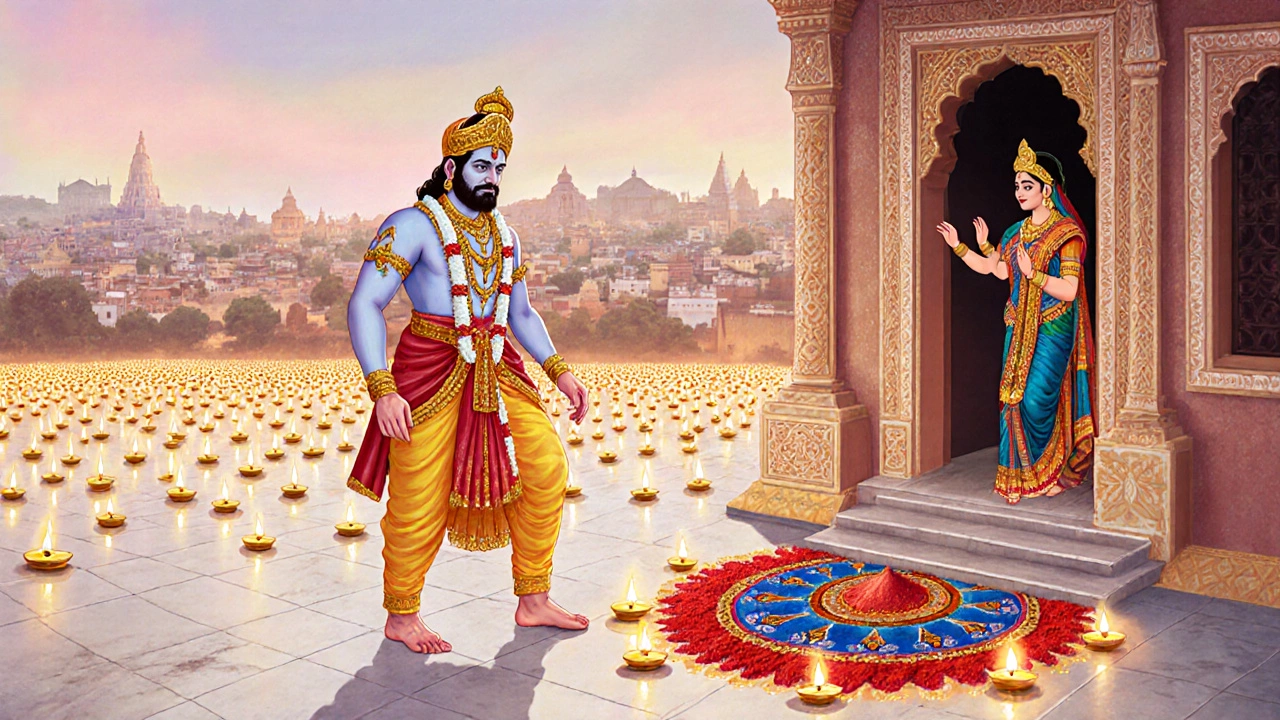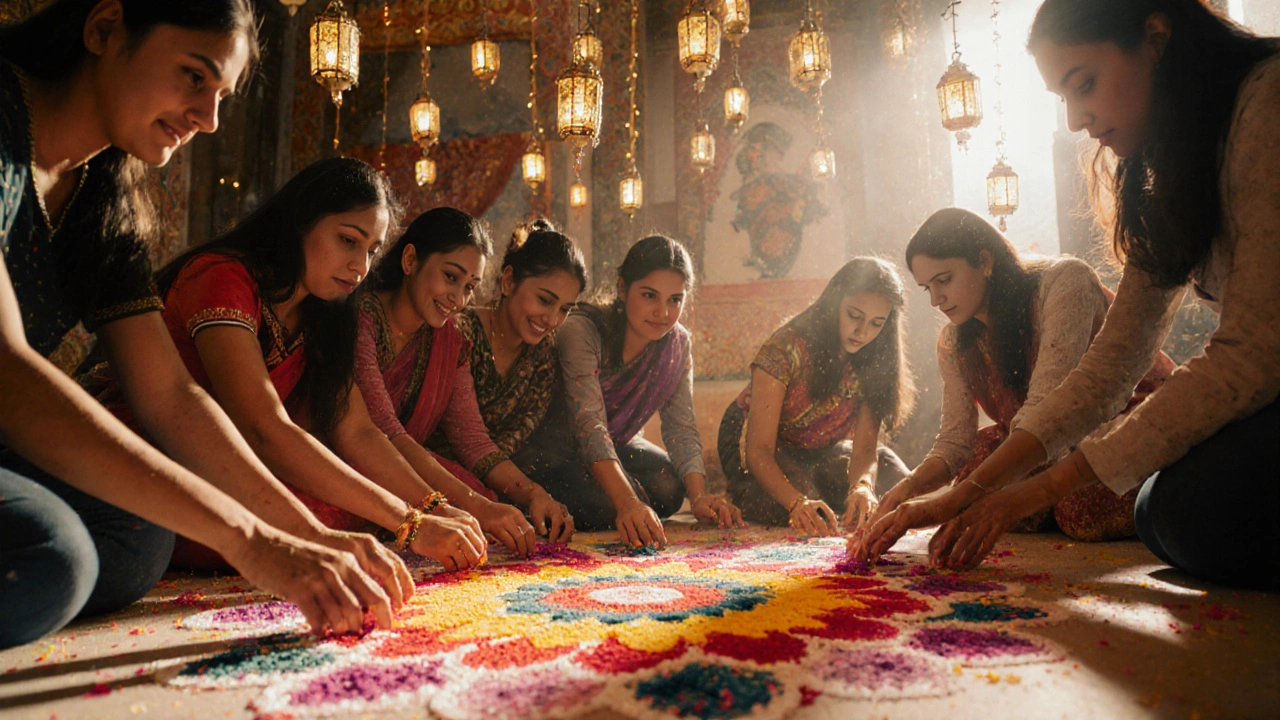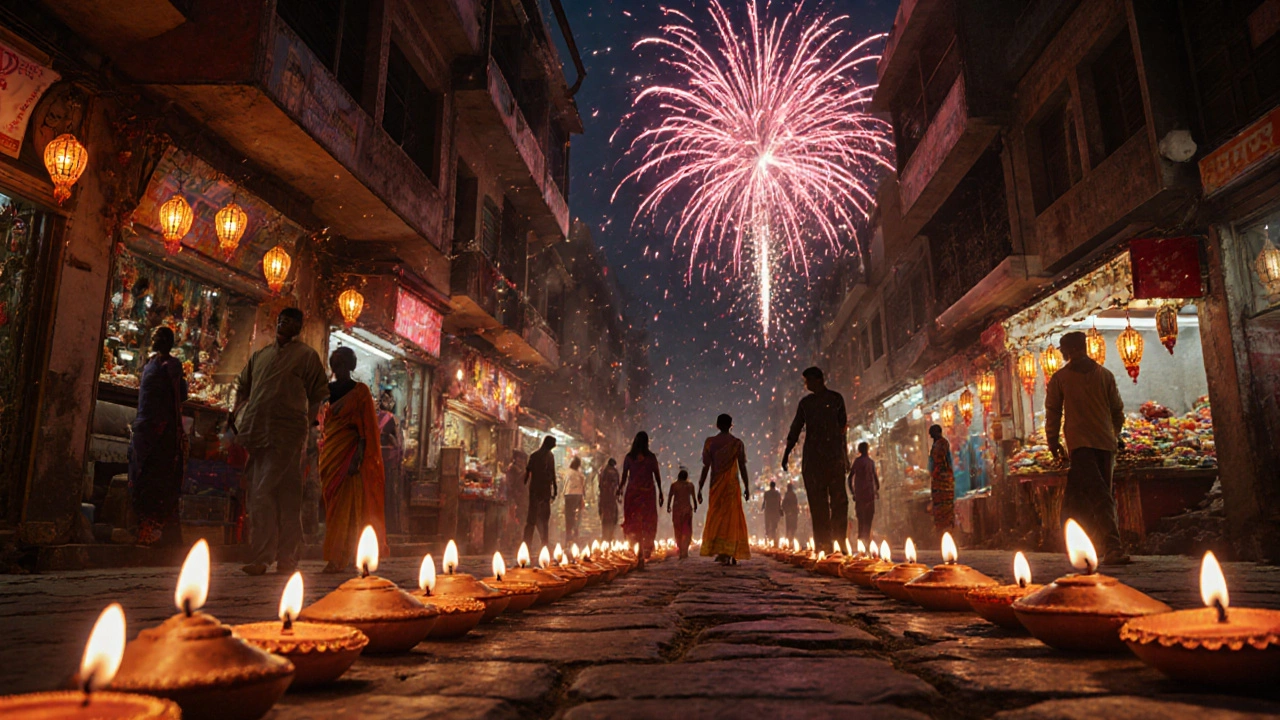When people think of India’s cultural calendar, the name that pops up first is famous Indian festival. That title belongs to Diwali - a five‑day celebration of lights, hope and new beginnings.
Quick Takeaways
- Diwali falls between October and November, depending on the lunar calendar.
- It honors the return of Lord Rama, the victory of light over darkness, and the goddess Lakshmi.
- Typical customs include lighting oil lamps (diyas), fireworks, sweets, and exchanging gifts.
- Regional variations add unique foods, rituals, and mythological stories.
- Visitors can join public rangoli displays, attend temple prayers, and enjoy street festivals.
What Makes Diwali Stand Out?
Diwali, also called the Festival of Lights, is celebrated by over a billion people worldwide. Its name comes from the Sanskrit word “dipti,” meaning illumination. The core idea is simple: darkness and ignorance are chased away by light and knowledge.
While the festival is rooted in Hindu tradition, its spirit resonates across religions in India. Sikh communities observe Bandi Chhor Divas, Jains celebrate the nirvana of Mahavira, and some Buddhists mark the day with gratitude ceremonies. This cross‑faith appeal fuels Diwali’s fame.
Historical Roots and Mythology
The most popular legend ties Diwali to the epic Ramayana. When Lord Rama returned to Ayodhya after a 14‑year exile and a victorious battle against Ravana, the citizens lit oil lamps to guide him home. That night, the city glowed like a galaxy.
Another story honors the goddess Lakshmi. She is believed to enter homes that are clean, bright and welcoming. Hence, many families perform deep cleaning and decorative lighting to invite her blessings of wealth and prosperity.
Key Rituals Across the Five Days
- Dhanteras - The first day focuses on wealth. People buy gold, silver, or new kitchen items, believing it attracts Lakshmi’s favor.
- Choti Diwali - Also called Naraka Chaturdashi, this day commemorates the defeat of the demon Narakasura. Homes are darkened early, then illuminated as a symbol of triumph.
- Diwali - The main night of lights. Families light diyas, set off fireworks, and perform Lakshmi puja.
- Govardhan Puja - In northern India, this day honors Lord Krishna’s lifting of Govardhan Hill. People prepare a hill‑shaped arrangement of food.
- Bhai Dooj - The final day celebrates sibling bonds. Sisters apply a decorative “tilak” on brothers’ foreheads and pray for their well‑being.

Regional Flavors of Celebration
India’s size ensures that Diwali looks different from Delhi to Delhi to Kolkata:
- North India: Grand firework displays, rangoli art on doorsteps, and lavish sweets like gajjak.
- West India (Gujarat, Maharashtra): Emphasis on decorative oil lamps, the “Deepavali” chant, and community “vyapaar” fairs.
- South India: Early morning “Karthikai Deepam” bonfires and the lighting of numerous lamps to symbolize spiritual enlightenment.
- East India (Bengal, Odisha): The celebration merges with “Durga Puja” festivities, offering an extended period of cultural programs.
How to Experience Diwali as a Visitor
- Join a local rangoli workshop: Many cultural centers in major cities (including Brisbane’s Indian community groups) teach you how to create colorful floor designs using colored powders.
- Attend a temple puja: Temples often welcome outsiders, offering a glimpse of the Lakshmi ritual. Remember to dress modestly and remove shoes.
- Sample traditional sweets: Treat yourself to laddu, jalebi, and barfi. Most Indian grocery stores stock them during the festive week.
- Watch fireworks safely: In Indian neighborhoods, firecrackers are set off after dusk. If you’re in a residential area, keep a safe distance and follow local regulations.
- Give a thoughtful gift: Small items like scented candles, decorative diyas, or handcrafted rangoli kits make appreciated Diwali presents.
Comparison of India’s Most Celebrated Festivals
| Festival | Typical Month | Primary Deity / Theme | Main Activities | Regional Highlight |
|---|---|---|---|---|
| Diwali | Oct‑Nov | Lord Rama & Goddess Lakshmi | Lighting diyas, fireworks, puja, sweets | Rangoli & firework shows in North India |
| Holi | Mar | Lord Krishna & color of spring | Throwing colored powders, water games | Vibrant processions in Mathura & Vrindavan |
| Navratri | Sept‑Oct | Goddess Durga | Garba dances, fasting, worship | Grand Durga pandals in West Bengal |
| Pongal | Jan | Sun God Surya | Cooking rice dish, cattle decoration | Harvest celebrations in Tamil Nadu |
| Onam | Aug‑Sept | King Mahabali | Boat races, flower carpets (pookalam) | State‑wide festivities in Kerala |

Common Pitfalls and How to Avoid Them
- Firecracker safety: Use only legally approved fireworks and keep a fire extinguisher nearby.
- Respecting religious sentiments: Avoid wearing black or white clothing during the puja, as these colors are associated with mourning.
- Overindulgence in sweets: Balance festive treats with light meals to stay healthy.
- Environmental concerns: Opt for eco‑friendly diyas made of clay and natural oils to reduce pollution.
Frequently Asked Questions
When does Diwali usually occur?
Diwali falls on the new moon day of the Hindu month Kartik, which typically lands between mid‑October and early November.
Why are oil lamps (diyas) so important?
Diyas symbolize the triumph of light over darkness and are believed to guide Goddess Lakshmi into homes, bringing prosperity.
Can non‑Hindus participate in Diwali celebrations?
Absolutely. Many cultural centres and Indian friends welcome guests. Simple gestures-like lighting a diya or sharing sweets-are appreciated.
What foods are traditional during Diwali?
Typical treats include laddu, jalebi, kaju katli, and savory samosas.
How can I celebrate Diwali responsibly in Australia?
Choose community events that use low‑noise fireworks, keep decorations fire‑safe, and respect local council regulations. Many Indian cultural groups in Brisbane host public rangoli and music nights that are family‑friendly.
Wrapping Up
Diwali’s blend of mythology, light‑filled rituals, and joyous gatherings makes it the standout famed Indian festival that travelers and locals alike cherish. Whether you’re lighting a single diya at home or joining a bustling street fest, the core message stays the same: welcome hope, share happiness, and let the light inside you shine.
